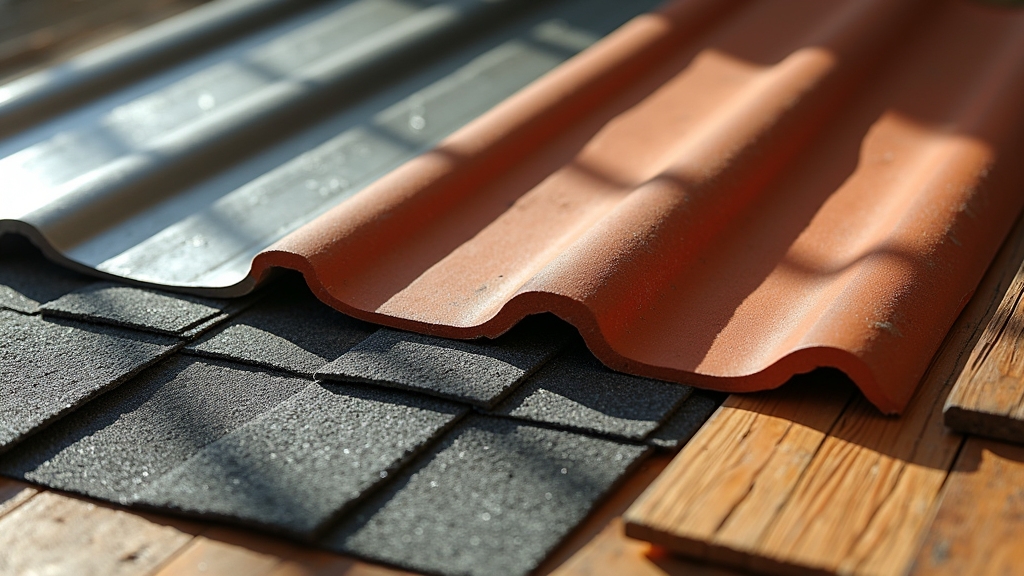Homeowners must understand several key aspects before replacing their roof. They should assess the current roof’s condition and evaluate material options, which can affect pricing and longevity. Budgeting is vital, with a contingency fund for unexpected costs. Selecting a qualified contractor requires confirming credentials and obtaining detailed estimates. Finally, managing local permits and insurance coverage is essential for compliance and financial protection. Further insights into maintaining a new roof for peak performance await.
Key Takeaways
- Conduct a thorough inspection of your current roof to identify issues like leaks, missing shingles, or damage before considering replacement.
- Understand the various roofing materials available, their costs, and how they affect your overall budget and roof lifespan.
- Obtain multiple estimates from licensed contractors and verify their insurance and experience to ensure quality work.
- Familiarize yourself with local building codes and necessary permits to avoid fines and ensure compliance during the replacement process.
- Plan for proper ventilation and ongoing maintenance to extend your new roof’s lifespan and prevent future damage.
Assessing the Condition of Your Current Roof

How can a homeowner effectively determine the condition of their roof? An initial visual inspection is vital; homeowners should look for missing, cracked, or curling shingles, as well as signs of granule loss.
Checking for leaks or water stains in the attic or ceiling can indicate underlying issues. Additionally, homeowners should assess the flashing around chimneys, vents, and skylights for rust or damage.
Moss or algae growth may suggest moisture retention, which can lead to decay.
Furthermore, homeowners should evaluate the roof’s age relative to its expected lifespan, as older roofs are more susceptible to failure.
A professional roof inspection can provide a thorough assessment, identifying structural concerns and potential hazards.
Documenting any findings and maintaining a maintenance log can assist in tracking the roof’s condition over time.
Understanding these elements is essential for making informed decisions regarding repairs or replacement.
Understanding Different Roofing Materials

Understanding different roofing materials is essential for homeowners considering a roof replacement.
Asphalt shingles are widely recognized for their affordability and ease of installation, while metal roofing offers advantages such as durability and energy efficiency.
Evaluating these options allows homeowners to make informed decisions based on their specific needs and budget.
Asphalt Shingles Overview
Asphalt shingles represent one of the most widely used roofing materials in residential construction due to their balance of affordability, durability, and aesthetic versatility. They are available in two primary types: organic and fiberglass, each providing distinctive benefits. Understanding these materials aids homeowners in making informed decisions during roof replacements.
| Type | Characteristics |
| Organic | Made from cellulose; more flexible; prone to algae growth. |
| Fiberglass | Composed of glass fibers; lighter; resistant to moisture. |
As a prevalent choice, asphalt shingles also offer various colors and styles, enabling customization to enhance a home’s exterior. Their lifecycle typically ranges from 15 to 30 years, contingent upon maintenance and environmental exposures, making them a practical option for many homeowners.
Metal Roofing Benefits

Metal roofing offers numerous advantages that make it an appealing alternative for homeowners considering roof replacements.
Its unique properties contribute to enhanced durability, energy efficiency, and aesthetic appeal.
Key benefits include:
- Longevity: Metal roofs can last 40-70 years, markedly outpacing traditional materials.
- Energy Efficiency: Reflective surfaces reduce heat absorption, enhancing energy savings.
- Low Maintenance: Metal roofing requires minimal upkeep compared to other materials, saving time and costs.
- Fire Resistance: Non-combustible nature provides superior protection against fire hazards.
These characteristics position metal roofing as a cost-effective and sustainable choice, ensuring homeowners make a well-informed decision when upgrading their roofing materials.
Budgeting for Your Roof Replacement
A thorough budget is essential for homeowners planning a roof replacement, as it helps guarantee that the project remains financially feasible. The first step involves evaluating the overall cost, which includes materials, labor, and potential permits.
Homeowners should consider various roofing materials, as costs can vary greatly, impacting the total budget. Additionally, it is prudent to allocate a contingency fund—typically 10-20% of the overall budget—to address unforeseen expenses, such as structural repairs or additional materials.
Homeowners must also be aware of local building codes and regulations, which may incur extra costs if compliance is required. Moreover, obtaining multiple estimates from different suppliers and contractors can provide a clearer picture of market rates.
Finding the Right Roofing Contractor
Selecting the right roofing contractor is a critical step in the roof replacement process. A proficient contractor can guarantee a successful installation, while the wrong choice may lead to costly mistakes.
Choosing a skilled roofing contractor is essential for a successful roof replacement and to avoid expensive errors.
Homeowners should meticulously evaluate potential candidates based on the following criteria:
- Licensing and Insurance: Confirm that the contractor holds valid licenses and adequate insurance to protect against liabilities.
- Experience and Reputation: Research the contractor’s history in the industry, including reviews and references from past clients.
- Warranty Offerings: Inquire about warranties on both materials and labor to safeguard against future issues.
- Detailed Estimates: Request written estimates detailing the scope of work, materials used, and timelines to guarantee transparency.
Navigating Permits and Insurance
Before commencing a roof replacement project, homeowners must navigate the complexities of permits and insurance, as these are essential components that can influence both the legality and safety of the installation.
Each locality has specific regulations governing roofing projects, requiring homeowners to obtain the necessary permits prior to initiating work. Failure to secure these permits could result in fines or mandated removal of the newly installed roof.
Insurance considerations are equally critical. Homeowners should verify that their existing homeowner’s policy covers roof replacement, as well as confirm that the roofing contractor possesses adequate liability insurance and worker’s compensation coverage.
This protects homeowners from financial liabilities in the event of accidents or property damage during the project. By diligently addressing permits and insurance, homeowners can guarantee a smoother roof replacement process, aligning their project with legal standards and safeguarding their investment.
Maintaining Your New Roof for Longevity
Maintaining a new roof is essential for ensuring its longevity and performance.
Regular inspections and maintenance, along with proper ventilation, play critical roles in preventing damage and extending the roof’s lifespan.
Additionally, routine cleaning and debris removal are necessary to mitigate potential hazards and promote peak functionality.
Regular Inspections and Maintenance
Regular inspections and maintenance are essential for ensuring the longevity of a newly installed roof. Homeowners are encouraged to adopt a proactive approach by incorporating the following practices:
- Biannual Inspections: Conduct thorough inspections in spring and fall to identify potential issues early.
- Debris Removal: Regularly clear gutters and roof surfaces of leaves, branches, and other debris that can trap moisture.
- Flashing Checks: Inspect flashing around vents, chimneys, and skylights for signs of wear or damage that could lead to leaks.
- Professional Assessments: Engage a roofing professional every few years to perform a detailed evaluation and recommend necessary repairs.
Proper Ventilation Importance
Effective roof maintenance extends beyond inspections and debris removal; proper ventilation plays a crucial role in preserving the integrity of roofing systems.
Adequate ventilation mitigates heat and moisture buildup in attic spaces, which can lead to premature deterioration of roofing materials. It allows for the escape of warm, humid air, thereby preventing condensation that fosters mold growth and wood rot.
Additionally, proper airflow enhances energy efficiency by regulating indoor temperatures, reducing the burden on HVAC systems. Homeowners should guarantee that their roofs are equipped with appropriate ventilation methods, such as ridge vents, soffit vents, or gable vents, to facilitate ideal air circulation.
Cleaning and Debris Removal
A consistent cleaning and debris removal routine is crucial for maximizing the lifespan of a new roof. Neglecting this maintenance can lead to significant damage, including mold growth and water infiltration.
Homeowners should implement the following strategies:
- Regular Inspections: Conduct bi-annual inspections to identify and address debris accumulation.
- Gutter Maintenance: Clear gutters and downspouts of leaves and sediment to guarantee proper water drainage.
- Debris Removal: Remove branches, leaves, and other debris from the roof surface to prevent rot and decay.
- Moss and Algae Treatment: Apply appropriate solutions to inhibit moss and algae growth, which can compromise roofing materials.
Frequently Asked Questions
How Long Does a Typical Roof Replacement Process Take?
A typical roof replacement process generally takes between one to three days, depending on factors such as roof size, materials used, weather conditions, and the complexity of the existing structure, necessitating careful planning and execution.
Can I Stay in My Home During the Roof Replacement?
Homeowners can typically remain in their residences during roof replacement; however, noise, debris, and safety concerns may necessitate temporary relocation. It is advisable to consult with contractors to assess specific circumstances and potential disruptions.
What Happens if It Rains During the Roof Replacement?
If it rains during roof replacement, exposed areas may suffer water damage, compromising structural integrity and insulation. Contractors typically employ tarps and other protective measures to mitigate risks, but unforeseen circumstances can still lead to complications.
Are There Warranties Available for New Roofs?
Yes, warranties are available for new roofs, typically covering material defects and workmanship. These warranties vary in duration and terms, often ranging from 10 to 50 years, depending on the manufacturer and installation practices employed.
How Can I Improve My Roof’s Energy Efficiency Post-Replacement?
To enhance post-replacement roof energy efficiency, homeowners can install reflective roofing materials, improve insulation, guarantee proper ventilation, and consider adding a cool roof coating, which collectively reduce heat absorption and lower energy consumption in residential settings.
Final Thoughts
In summary, replacing your roof is a major investment that demands careful planning, research, and the right professional support. From evaluating your roof’s current condition and exploring durable roofing materials such as asphalt shingles, metal roofing, or composite roofing, to securing the necessary permits and budgeting wisely, every step contributes to your home’s safety and long-term value. Choosing a licensed and experienced contractor ensures that your project meets quality standards and local compliance requirements.
To protect your investment, schedule regular roof inspections and maintenance with trusted professionals. Proper upkeep extends the lifespan of your roof, improves energy efficiency, and preserves your property’s curb appeal.
If you’re ready to upgrade or replace your roof, trust 180 CONTRACTORS ROOFING STERLING HEIGHTS — your local experts for high-quality roof installations, repairs, and replacements across the Sterling Heights area and nearby communities such as Troy, Rochester Hills, and Warren.Call us today at (586) 331-0594 or contact us online for a free, no-obligation estimate and discover why homeowners trust us for dependable roofing solutions that last.
